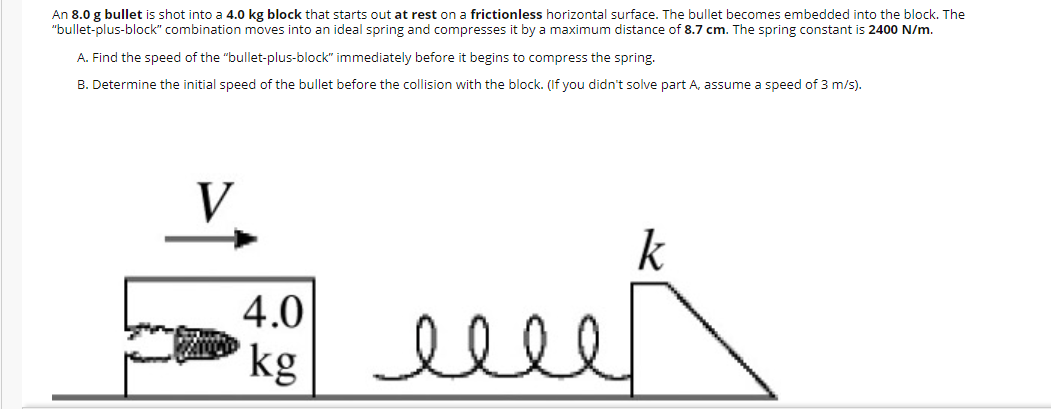An 8.0 g bullet is shot into a 4.0 kg block that starts out at rest on a frictionless horizontal surface. The bullet becomes embedded into the block. The "bullet-plus-block" combination moves into an ideal spring and compresses it by a maximum distance of 8.7 cm. The spring constant is 2400 N/m. A. Find the speed of the "bullet-plus-block" immediately before it begins to compress the spring. B. Determine the initial speed of the bullet before the collision with the block. (If you didn't solve part A, assume a speed of 3 m/s). V 4.0 elled kg
An 8.0 g bullet is shot into a 4.0 kg block that starts out at rest on a frictionless horizontal surface. The bullet becomes embedded into the block. The "bullet-plus-block" combination moves into an ideal spring and compresses it by a maximum distance of 8.7 cm. The spring constant is 2400 N/m. A. Find the speed of the "bullet-plus-block" immediately before it begins to compress the spring. B. Determine the initial speed of the bullet before the collision with the block. (If you didn't solve part A, assume a speed of 3 m/s). V 4.0 elled kg
Principles of Physics: A Calculus-Based Text
5th Edition
ISBN:9781133104261
Author:Raymond A. Serway, John W. Jewett
Publisher:Raymond A. Serway, John W. Jewett
Chapter7: Conservation Of Energy
Section: Chapter Questions
Problem 15P: A block of mass m = 2.00 kg is attached to a spring of force constant k = 500 N/m as shown in Figure...
Related questions
Question
need help with this physics question

Transcribed Image Text:An 8.0 g bullet is shot into a 4.0 kg block that starts out at rest on a frictionless horizontal surface. The bullet becomes embedded into the block. The
"bullet-plus-block" combination moves into an ideal spring and compresses it by a maximum distance of 8.7 cm. The spring constant is 2400 N/m.
A. Find the speed of the "bullet-plus-block" immediately before it begins to compress the spring.
B. Determine the initial speed of the bullet before the collision with the block. (If you didn't solve part A, assume a speed of 3 m/s).
V
4.0
elled
kg
Expert Solution
This question has been solved!
Explore an expertly crafted, step-by-step solution for a thorough understanding of key concepts.
This is a popular solution!
Trending now
This is a popular solution!
Step by step
Solved in 2 steps with 2 images

Knowledge Booster
Learn more about
Need a deep-dive on the concept behind this application? Look no further. Learn more about this topic, physics and related others by exploring similar questions and additional content below.Recommended textbooks for you

Principles of Physics: A Calculus-Based Text
Physics
ISBN:
9781133104261
Author:
Raymond A. Serway, John W. Jewett
Publisher:
Cengage Learning

Physics for Scientists and Engineers: Foundations…
Physics
ISBN:
9781133939146
Author:
Katz, Debora M.
Publisher:
Cengage Learning

College Physics
Physics
ISBN:
9781285737027
Author:
Raymond A. Serway, Chris Vuille
Publisher:
Cengage Learning

Principles of Physics: A Calculus-Based Text
Physics
ISBN:
9781133104261
Author:
Raymond A. Serway, John W. Jewett
Publisher:
Cengage Learning

Physics for Scientists and Engineers: Foundations…
Physics
ISBN:
9781133939146
Author:
Katz, Debora M.
Publisher:
Cengage Learning

College Physics
Physics
ISBN:
9781285737027
Author:
Raymond A. Serway, Chris Vuille
Publisher:
Cengage Learning

College Physics
Physics
ISBN:
9781305952300
Author:
Raymond A. Serway, Chris Vuille
Publisher:
Cengage Learning

Physics for Scientists and Engineers with Modern …
Physics
ISBN:
9781337553292
Author:
Raymond A. Serway, John W. Jewett
Publisher:
Cengage Learning

Physics for Scientists and Engineers
Physics
ISBN:
9781337553278
Author:
Raymond A. Serway, John W. Jewett
Publisher:
Cengage Learning